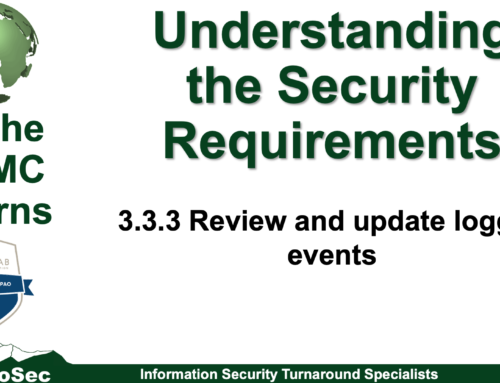Organization’s struggle with documenting NIST SP 800-171’s 3.3.1 System Auditing, especially when they are using Commercial Off the Shelf (COTS) software or cloud services.
Like all of the other As the CMMC Churns Understand the Requirements series, we will you through understand the key definitions, the Assessment Objectives, and demonstrate how we show conformity to 3.3.1 System Auditing using SharePoint lists and Azure Sentinel.
This Understand the Requirements video will be critical when we get to 3.3.3, Review and Update Logged Events, a THOROUGHLY misunderstood requirement.
3.3.1, System Auditing
|
3.3.1 |
SECURITY REQUIREMENT Create and retain system audit logs and records to the extent needed to enable the monitoring, analysis, investigation, and reporting of unlawful or unauthorized system activity. |
|
|
|
DISCUSSION An event is any observable occurrence in a system, which includes unlawful or unauthorized system activity. Organizations identify event types for which a logging functionality is needed as those events which are significant and relevant to the security of systems and the environments in which those systems operate to meet specific and ongoing auditing needs. Event types can include password changes, failed logons or failed accesses related to systems, administrative privilege usage, or third-party credential usage. In determining event types that require logging, organizations consider the monitoring and auditing appropriate for each of the CUI security requirements. Monitoring and auditing requirements can be balanced with other system needs. For example, organizations may determine that systems must have the capability to log every file access both successful and unsuccessful, but not activate that capability except for specific circumstances due to the potential burden on system performance. Audit records can be generated at various levels of abstraction, including at the packet level as information traverses the network. Selecting the appropriate level of abstraction is a critical aspect of an audit logging capability and can facilitate the identification of root causes to problems. Organizations consider in the definition of event types, the logging necessary to cover related events such as the steps in distributed, transaction-based processes (e.g., processes that are distributed across multiple organizations) and actions that occur in service-oriented or cloud-based architectures. Audit record content that may be necessary to satisfy this requirement includes time stamps, source and destination addresses, user or process identifiers, event descriptions, success or fail indications, filenames involved, and access control or flow control rules invoked. Event outcomes can include indicators of event success or failure and event-specific results (e.g., the security state of the system after the event occurred). Detailed information that organizations may consider in audit records includes full text recording of privileged commands or the individual identities of group account users. Organizations consider limiting the additional audit log information to only that information explicitly needed for specific audit requirements. This facilitates the use of audit trails and audit logs by not including information that could potentially be misleading or could make it more difficult to locate information of interest. Audit logs are reviewed and analyzed as often as needed to provide important information to organizations to facilitate risk-based decision making. [SP 800-92] provides guidance on security log management. |
|
|
ASSESSMENT OBJECTIVE Determine if: |
||
|
3.3.1[a] |
audit logs needed (i.e., event types to be logged) to enable the monitoring, analysis, investigation, and reporting of unlawful or unauthorized system activity are specified. |
|
|
3.3.1[b] |
the content of audit records needed to support monitoring, analysis, investigation, and reporting of unlawful or unauthorized system activity is defined. |
|
|
3.3.1 |
audit records are created (generated). |
|
|
3.3.1[d] |
audit records, once created, contain the defined content. |
|
|
3.3.1[e] |
retention requirements for audit records are defined. |
|
|
3.3.1[f] |
retention requirements for audit records are defined. |
|
|
POTENTIAL ASSESSMENT METHODS AND OBJECTS |
||
|
Examine |
[SELECT FROM: Audit and accountability policy; procedures addressing auditable events; system security plan; system design documentation; system configuration settings and associated documentation; procedures addressing control of audit records; procedures addressing audit record generation; system audit logs and records; system auditable events; system incident reports; other relevant documents or records]. |
|
|
Interview |
[SELECT FROM: Personnel with audit and accountability responsibilities; personnel with information security responsibilities; personnel with audit review, analysis and reporting responsibilities; system or network administrators]. |
|
|
Test |
[SELECT FROM: Mechanisms implementing system audit logging]. |
|






Social Contact